Sensor Sweep: Blizzard, DAW Books, James Bond, The Night Stalker
Monday , 8, November 2021 Sensor Sweep 2 CommentsGaming (Game Spot): Activision Blizzard’s stock price started the day on Wednesday, November 3, down by more than 14% on the New York Stock Exchange following an earnings release on Tuesday where the company announced delays for Overwatch 2 and Diablo IV and made other announcements that might have spooked investors.
Activision Blizzard posted revenue of $2.07 billion for the quarter ended September 30 and a profit of $639 million.
Movie Review (Taki Mag): Dune is an extraordinarily impressive (if not utterly enjoyable) adaptation of the first half of the epic 1965 science-fiction novel that George Lucas borrowed heavily from for his boys’ version in Star Wars. The book by Frank Herbert, a GOP speechwriter who sensed early various late-’60s currents such as drugs and ecology, is a spectacular pastiche set 21,000 years in the future under a galactic empire where, because intelligent aliens don’t exist and technology is advanced but stagnant, human politics is all-consuming.
not utterly enjoyable) adaptation of the first half of the epic 1965 science-fiction novel that George Lucas borrowed heavily from for his boys’ version in Star Wars. The book by Frank Herbert, a GOP speechwriter who sensed early various late-’60s currents such as drugs and ecology, is a spectacular pastiche set 21,000 years in the future under a galactic empire where, because intelligent aliens don’t exist and technology is advanced but stagnant, human politics is all-consuming.
Science Fiction (DMR Books): Today marks the anniversary of the passing of Donald A. Wollheim—a man whom I consider, overall, the greatest SFF editor in the history of the genre. Today also marks—perhaps precisely, perhaps within a few weeks at most—the founding of DAW Books by Wollheim in 1971. DAW, an acronym of Wollheim’s initials, was the first major paperback publisher devoted to science fiction and fantasy. During the fifteen years that Don had a firm hand on the reins, DAW Books punched far above its weight.
perhaps within a few weeks at most—the founding of DAW Books by Wollheim in 1971. DAW, an acronym of Wollheim’s initials, was the first major paperback publisher devoted to science fiction and fantasy. During the fifteen years that Don had a firm hand on the reins, DAW Books punched far above its weight.
Robert E. Howard (Adventures Fantastic): It being that time of year when night starts coming earlier and earlier, ghoulies and ghosties start showing up in the stores, and Texas finally starts to receive cooler temperatures, I thought it would be fun to look at some of Robert E. Howard’s favorite supernatural and horror tales that he was told or learned about. Not horror fiction, but the “real” ghost tales and weird stuff that folks tell around a campfire. The old “a friend of a friend heard this” stuff. Of course, during Howard’s life, Halloween had not yet begun to develop its modern traditions of kids dressing up and going door to door begging for treats, or adults having parties.
Culture (Wasteland & Sky): Have you ever woken up and had the impression that you are not where you’re supposed to be? That this world isn’t right, and that you’re missing something that should be blatantly obvious, yet isn’t? You probably have, especially these days. The world has changed so radically over the last decade and is changing even faster over smaller periods of time.
James Bond (Bounding Into Comics): Ian Fleming Publications authorized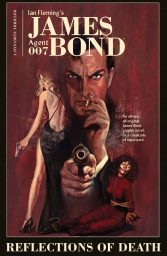 novelist and University of Edinburgh lecturer Kim Sherwood to pen a new trilogy of James Bond novels where Bond is not featured, and where a number of classic characters will be reimagined. The Guardian reports that Sherwood signed a deal with HarperCollins “to write three contemporary thrillers set in the world of James Bond but where the original 007 is missing, presumed captured or even killed.”
novelist and University of Edinburgh lecturer Kim Sherwood to pen a new trilogy of James Bond novels where Bond is not featured, and where a number of classic characters will be reimagined. The Guardian reports that Sherwood signed a deal with HarperCollins “to write three contemporary thrillers set in the world of James Bond but where the original 007 is missing, presumed captured or even killed.”
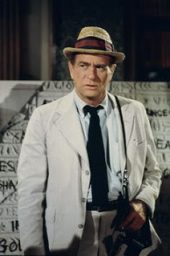 T.V. (Arkhaven Comics): It started with a made-for-TV movie (75 minutes without commercials) that scared the unholy crappity, crapping crap out of me when I was a kid. It kept me up for a week. My parents were furious with ABC for airing it in the first place. That flick was terrifying back then but now I can’t help but look at it and wonder why I’d ever been so frightened by it? The history of horror is basically a history of what we aren’t all that frightened of anymore.
T.V. (Arkhaven Comics): It started with a made-for-TV movie (75 minutes without commercials) that scared the unholy crappity, crapping crap out of me when I was a kid. It kept me up for a week. My parents were furious with ABC for airing it in the first place. That flick was terrifying back then but now I can’t help but look at it and wonder why I’d ever been so frightened by it? The history of horror is basically a history of what we aren’t all that frightened of anymore.
RPG (Kairos): Let’s focus on WoD’s flagship game, Vampire: The Masquerade. What sets Vampire worlds apart from every other major game I can think of is that it doesn’t shy away from religion–and more amazingly in this age of apostasy, that religion is unambiguously biblical and Abrahamic. Vampire’s lead designer Mark Rein-Hagen has publicly stated that he wanted to make a game about religion. His upbringing as the son of a Lutheran pastor shows in the surprising competence of the final product.
Art (DMR Books): P. Craig Russell is an artist with a nearly half-century career in comics. His seventieth birthday was last weekend. Samhain shenanigans prevented me posting about it then. Time for a belated congrats.
career in comics. His seventieth birthday was last weekend. Samhain shenanigans prevented me posting about it then. Time for a belated congrats.
Philip Craig Russell was born in Ohio and took to art early on. He had this to say in a 2010 interview:
Horror (With Both Hands): I find it entirely appropriate to put up my review of Bram Stoker’s justly famous Dracula on the Feast of All Saints, November 1st. Like all of the best horror, Dracula is about how the unconquerable power of God works itself out in our broken and sinful world through the acts of the men and women He calls Dracula.
Cinema (According to Quinn): Once upon a time in elementary school, I was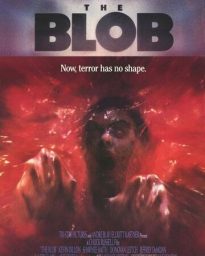 a regular reader of the Crestwood Monsters series, a series of children’s books in which the tales of the classical movie monsters (Dracula, the Wolfman, etc.) were retold using black-and-white film stills as illustrations. One such book was centered around the 1950s horror film The Blob. I was aware there was a remake in the 1980s, but never got around to seeing it until Myopia Movies did an episode on it. I wasn’t able to participate, but I saw it later when the episode came out.
a regular reader of the Crestwood Monsters series, a series of children’s books in which the tales of the classical movie monsters (Dracula, the Wolfman, etc.) were retold using black-and-white film stills as illustrations. One such book was centered around the 1950s horror film The Blob. I was aware there was a remake in the 1980s, but never got around to seeing it until Myopia Movies did an episode on it. I wasn’t able to participate, but I saw it later when the episode came out.
Vintage Fiction (Don Herron): Recently Vince Emery sent along a copy of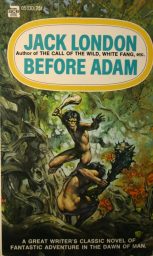 Sterling’s Babes in the Wood, first book publication of the poet’s sort-of sequel to Jack London’s Before Adam. In his years as a publisher Vince has knocked out a little bit of this, some of that, an eclectic mix anchored thus far by some intimate connection to the city of San Francisco. I figured I should look into the original first, and as I poked through London’s primeval tale didn’t pick up any ghost memories of having read it years ago. The framing device was quite familiar, since it heavily influenced Robert E. Howard’s Sword-and-Sorcery yarns involving ancestral memories, such as “The Valley of the Worm.”
Sterling’s Babes in the Wood, first book publication of the poet’s sort-of sequel to Jack London’s Before Adam. In his years as a publisher Vince has knocked out a little bit of this, some of that, an eclectic mix anchored thus far by some intimate connection to the city of San Francisco. I figured I should look into the original first, and as I poked through London’s primeval tale didn’t pick up any ghost memories of having read it years ago. The framing device was quite familiar, since it heavily influenced Robert E. Howard’s Sword-and-Sorcery yarns involving ancestral memories, such as “The Valley of the Worm.”
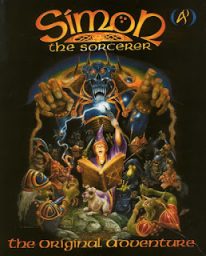 Games (Player None): In the 1990s, there were two names for adventure games: Sierra and Lucasarts. Of course, there were other contenders as well, but few managed to become as well-liked as Adventuresoft’s Simon the Sorcerer. Or at least Simon the Sorcerer was a hit in Europe, I have no idea how well the (mis)adventures of the sarcastic teenage sorcerer went down elsewhere.
Games (Player None): In the 1990s, there were two names for adventure games: Sierra and Lucasarts. Of course, there were other contenders as well, but few managed to become as well-liked as Adventuresoft’s Simon the Sorcerer. Or at least Simon the Sorcerer was a hit in Europe, I have no idea how well the (mis)adventures of the sarcastic teenage sorcerer went down elsewhere.
Science Fiction (M Porcius): We just read Henry Kuttner and C. L. Moore’s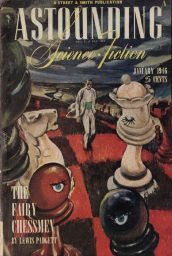 The Fairy Chessmen, a two-part serial that appeared in the January and February issues of Astounding in 1946. Let’s see what else was in the Jan. ’46 issue of John W. Campbell, Jr’s formidable magazine. Campbell’s editorial is about how nuclear proliferation will change foreign policy and foreign relations; he assumes that every advanced nation, including places like Belgium and Czechoslovakia, will soon have its own arsenal of atomic weapons and the U. S. had better develop some kind of defense tout suite.
The Fairy Chessmen, a two-part serial that appeared in the January and February issues of Astounding in 1946. Let’s see what else was in the Jan. ’46 issue of John W. Campbell, Jr’s formidable magazine. Campbell’s editorial is about how nuclear proliferation will change foreign policy and foreign relations; he assumes that every advanced nation, including places like Belgium and Czechoslovakia, will soon have its own arsenal of atomic weapons and the U. S. had better develop some kind of defense tout suite.
Cinema (Catholic Herald): Recently, in anticipation of seeing No Time to Die (2021) in the cinema, I re-watched all Daniel Craig’s James Bond films. Ten-odd hours of shooting, car chases and gratuitous close-ups later, I had learnt something new about Bond – he’s Catholic. Or, at least, he comes from a family of Catholics. In Skyfall (2012), Bond and M travel back to his family home – on bleakest Scottish moorland – to lure a villain into a fireball trap.
Tolkien (Sagas From the Sea): This brings me to The Legend of Sigurd & Gudrún, published in 2009 by HarperCollins. It takes the form of two poems, interspersed with Christopher Tolkien’s commentaries and annotations. The first is Völsungakviđa en nỳja (The New Lay of the Völsungs), which recounts the mythic origins of the Volsung family, the hero Sigmund and his dragon-slayer son Sigurd, and Sigurd’s love for two women, the Valkyrie Brynhild and the beautiful Gudrún.
D&D (Polygon): The first DM’s guide was a look into Gygax’s campaign —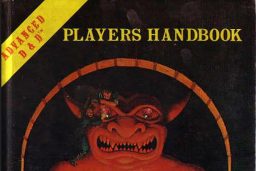 seeing his influences, what mattered to him and what was interesting. It was the total opposite of the sanitized, system-focused design that came with later editions of D&D and were pioneered, at least in my head, by GURPS, an amazing system in its own right. That kind of grit was the residue of Gygax’s imagination in the game’s systems. It gave First Edition a lot of its texture and wonder. His heroes, his villains, his artifacts.
seeing his influences, what mattered to him and what was interesting. It was the total opposite of the sanitized, system-focused design that came with later editions of D&D and were pioneered, at least in my head, by GURPS, an amazing system in its own right. That kind of grit was the residue of Gygax’s imagination in the game’s systems. It gave First Edition a lot of its texture and wonder. His heroes, his villains, his artifacts.
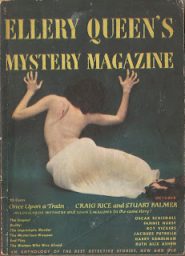 Fiction (M Porcius): On a recent visit to the Wonder Book location in Frederick, MD, I found on the outside 95¢ shelves a pile of old Ellery Queen Mystery Magazines. I flipped through them and selected some with stories by SF writers I am interested in like Avram Davidson and Robert Bloch. When I brought them to the counter, the clerk told me that because of a current sale I could get three more for free, so I scooted outside and just grabbed three 1950s issues whose covers I liked because they depicted young ladies in distress.
Fiction (M Porcius): On a recent visit to the Wonder Book location in Frederick, MD, I found on the outside 95¢ shelves a pile of old Ellery Queen Mystery Magazines. I flipped through them and selected some with stories by SF writers I am interested in like Avram Davidson and Robert Bloch. When I brought them to the counter, the clerk told me that because of a current sale I could get three more for free, so I scooted outside and just grabbed three 1950s issues whose covers I liked because they depicted young ladies in distress.
Fiction (Paperback Warrior): Steve Frazee was a prolific western author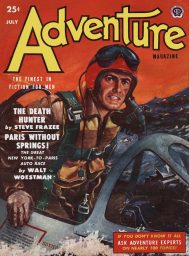 that served as president of the Western Writers of America. Before authoring full-length paperbacks in the 1950s, Frazee was a heavy contributor to the western and adventure pulps of the 1940s. We’ve covered several of his books and stories here on Paperback Warrior, so I was happy to locate another of his short stories. “The Death Hunter” appeared in the July, 1952 issue of Adventure Magazine.
that served as president of the Western Writers of America. Before authoring full-length paperbacks in the 1950s, Frazee was a heavy contributor to the western and adventure pulps of the 1940s. We’ve covered several of his books and stories here on Paperback Warrior, so I was happy to locate another of his short stories. “The Death Hunter” appeared in the July, 1952 issue of Adventure Magazine.
History (Western Fictioneers): November 5 marks the 150th anniversary of the “Wickenburg Massacre,” a stagecoach shootout that, to this day, still inspires lively and sometimes heated arguments among historians. The arguments are about who actually did the killing. Was it the local indigenous people, the Yavapai? Was it Mexicans? Or white men? A combination of all three? The problem is that the evidence left behind can be interpreted a number of ways, and the even the two survivors gave conflicting (and sometimes changing) stories.
I hadn’t heard of Before Adam, much less Babes in the Wood. I definitely liked White Fang; London’s depiction of a wild dog’s experience from his POV felt accurate. I’ve never been a dog, so what do I know?
-
BEFORE ADAM was, indisputably, and influence on both Burroughs and Howard. Excellent ‘caveman’ fiction. London also wrote a lot of other ‘SF’ and ‘fantasy’ tales. Check this out for an overview:
https://dmrbooks.com/test-blog/2019/1/12/forefathers-of-sword-and-sorcery-jack-london